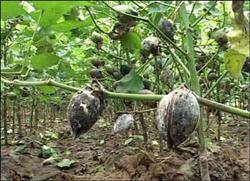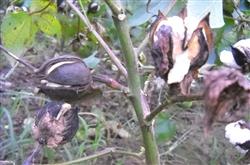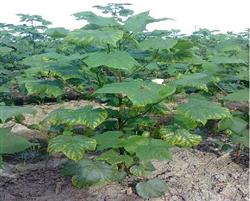How to prevent cotton boll rot with high temperature and humidity?

How to prevent cotton boll rot with high temperature and humidity? Please introduce the methods of cotton boll rot prevention and control with reference to the following methods: 1. Rational fertilization: increase the application of organic fertilizer and phosphorus and potassium fertilizer, and apply appropriate amount of nitrogen fertilizer to prevent cotton plant growth, reduce cotton field closure, and improve ventilation and light transmission. 2. Timely drainage: for cotton fields with low-lying terrain, poor drainage and heavy water accumulation, the drainage ditch should be deepened in order to speed up the drainage speed. Eliminate the bright, waterlogging and dark stains in the cotton field, improve the environmental conditions of cotton growth and development, realize the cotton to bear more peaches, not premature senescence, and reduce the harm of boll disease. In addition, for the drainage of cotton fields and the prevention of cotton lodging, soil cultivation before cotton flowering is also an effective agronomic measure, which should be promoted. 3. Moderate chemical control: in the cotton field with better fertilizer and water conditions, the cotton plant is easy to grow, so it should be sprayed reasonably in the early and middle stages of cotton growth to regulate the growth of cotton, prevent the excessive growth of cotton plant and reduce the damage of boll disease. 4. Adjusting boll setting: there are too many peaches in plastic film cotton or early cotton. By taking effective measures to adjust the boll setting period and boll setting position of cotton, the rotten boll can be reduced. Early-onset cotton advocates to remove the early buds or the first and second fruit branches from the lower 1-4 fruit branches as soon as possible. 5. Reasonable pruning: for cotton fields with too narrow row spacing and premature closure, in order to reduce excessive depression in the field and improve the lighting and ventilation conditions in the middle and lower parts, the edge center should be removed as soon as possible, which can reduce bud and boll shedding and boll rot. 6. Ploughing and loosening soil between rows is advocated, the ground consolidation is broken, the humidity of cotton field is reduced, the environmental conditions of cotton growth are improved, and the rotten bolls of cotton can be reduced. 7. Pick the sunburn boll: the cotton peach whose shell has faded and turned yellow and begins to appear black spots after the boll period is more than 40 days shall be harvested before rotten. The harvested cotton peaches were dipped in ethephon solution with a concentration of 1% and then dried, and the cotton with better boll opening could be obtained. 8. Intercropping and interplanting: reasonable intercropping and intercropping has obvious disease control effect on cotton boll disease, and wheat-cotton, cotton-vegetable and cotton-melon double cropping system has better disease control effect. 9. Chemical control: chemical control is an important measure for comprehensive control of cotton boll rot, and targeted fungicide spray should be carried out. From August to September, when the weather forecast has cloudy and rainy weather for several consecutive days, spray protection should be carried out in time. Spraying should be concentrated in the middle and lower part of the cotton plant. The commonly used agents are carbendazim 1000 times solution, 58% metalaxyl ·manganese zinc wettable powder dilution 600 times 800 times, 80% spray gram wettable powder 500 times dilution 500 times, 70% chlorothalonil wettable powder dilution 500 times, and so on. 10. emergency measures: if there are too many cloudy and rainy days in the later stage of cotton growth, the cotton field is overshadowed and the humidity is too high, the problem of cotton boll rot is still not effectively controlled (this situation is generally rare or the area is very small). After fully weighing the cotton boll rot and affecting the development and loss of the upper cotton boll, emergency measures should be taken. Get rid of the middle and lower leaves of cotton, or push plants and ridges, thoroughly improve the ventilation and light transmission of cotton fields, reduce the humidity of cotton fields, reduce the rotten bolls, reduce the loss, and obtain the due harvest. It is particularly noted that this measure is only applied as an emergency measure, and if applied prematurely or improperly, cotton production will be reduced and fiber quality will be affected. Click to get more cotton planting technology click to get more food crop planting technology
- Prev

Why is the cotton rotten? How to prevent cotton boll rot?
Why is the cotton rotten? How to prevent cotton boll rot? Please introduce the rotten bolls of cotton, which occurs to varying degrees almost every year. Therefore, on the basis of understanding the conditions and causes of cotton boll rot, comprehensive measures should be taken to reduce the loss to the minimum. One.
- Next

How to manage and prevent the premature senescence of cotton in the later stage?
How to manage and prevent the premature senescence of cotton in the later stage? Please introduce the methods to prevent and control the premature senescence of cotton in the later stage, you can refer to the following methods for management: first, fertilizer and water management should re-apply flower and boll fertilizer according to cotton plant situation, climate and soil conditions, such as insufficient flower and boll fertilizer, and then apply top fertilizer. After entering the middle of August, if Tian.
Related
- The first cup of black tea in spring, the flavor and history of tea gardens in Kenya, Africa
- The computer can not only choose potatoes, but also grow tea rice. AI will grow winter oolong tea champion.
- It is not only the inflated tea bitten by insects, but also engraved with the four seasons tea in Beipu.
- The Oriental Beauty Tea Festival in Zhuxian County takes the stage at the weekend to experience the plus-size feast of oil tea.
- & quot; Oriental Beauty Tea & Exploration of Emei in Hsinchu, the hometown of quot;
- The new variety of strawberry "Tainong 1" dessert is the first choice with mellow aroma. Crimson gorgeous
- History of Tea in Taiwan: from Wild Inner Mountain to Export Tea Garden
- Two types of Taiwan Oriental Beauty Black Tea won the British three-Star Award for Childhood Tea Xiang Zhang Jiaqi changed from pilot to champion tea maker.
- Banana species and varieties: the planting history of Taiwan Xianren banana and dwarf banana is long, is banana disease resistant?
- Coffee planting Technology: Qianjie Coffee from Seedling to harvesting

